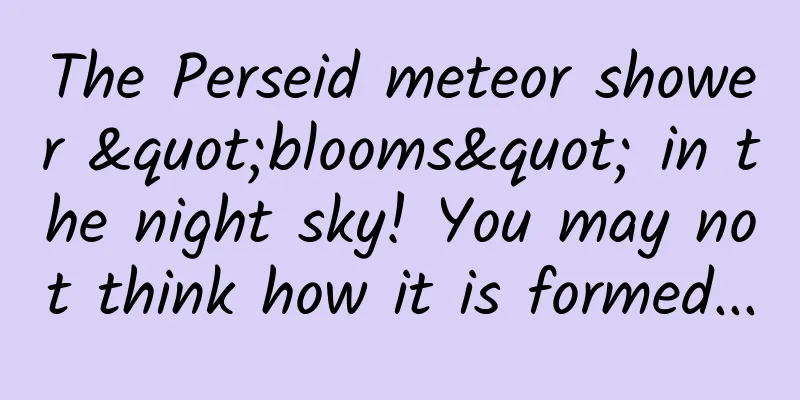The Perseid meteor shower "blooms" in the night sky! You may not think how it is formed...

|
Produced by: Science Popularization China Author: Han Xiaohong and Yun Chaoang (Xinjiang Astronomical Observatory, Chinese Academy of Sciences) Producer: China Science Expo meteor The Milky Way is quiet on a cold night in early autumn. The sky is full of stars and there is no moon. Suddenly I saw a knife breaking through the sky. Falling to earth and unknown. From 21:00 on August 12, 2024 to 0:00 on August 13, the Perseid meteor shower, one of the three major meteor showers in the northern hemisphere (the Quadrantids and the Geminids), reached its maximum, with a flow rate of up to 100 meteors per hour. That night, as the moon set from the west, it was an excellent time to observe the meteor shower. Astronomy enthusiasts at the Qitai Observatory of the Xinjiang Astronomical Observatory of the Chinese Academy of Sciences looked up at the starry sky and enjoyed this astronomical spectacle together. Figure 1 The Perseid meteor shower captured by the Qitai Observatory of Xinjiang Astronomical Observatory in the early morning of August 12, 2024 (Photo source: taken by myself) 1. What are meteors and meteor showers? Outside the Earth's atmosphere, there is interstellar matter composed of rocks, ice, etc. When they meet the Earth head-on, their speed is quite high, reaching 70km/s. Even if they catch up with the Earth and enter the atmosphere, their relative speed can reach 10km/s, which is more than 10 times the speed of a bullet leaving the gun. It is enough to collide and rub with atmospheric molecules and atoms to burn and glow, and they can be seen as meteors with the naked eye. Most meteoroids vaporize after entering the atmosphere. Only a few large and solid meteoroids have residual solid matter that falls to the ground due to incomplete burning. These are meteorites. According to observation data, the total mass of meteoroids that fall to the earth every year, including vaporized matter and micrometeorites, is about 50 tons! Will this make the earth "fatter"? In fact, the mass of the earth is about 6×10^21 tons, so the total amount of the increase in the "weight" of the earth in 5 billion years caused by the falling meteoroids is about 3.3×10^17 tons, or the increase of one 20,000th of the mass of the earth, which is equivalent to a 0.01 catties increase in a person weighing 200 catties. It can be seen that the meteoroids that fall to the earth every year are actually insignificant to the earth! Figure 2 Meteoroid entering the Earth's atmosphere (Photo source: veer photo gallery) There are several types of meteors, such as sporadic meteors, fireballs, and meteor showers. Meteors that appear densely like rain are called meteor showers. Generally, meteor showers are concentrated in a certain period of time. The meteor showers produced in this period of time seem to radiate from a fixed point in the sky. This point is called the radiant point. The name of the meteor shower is also related to the constellation in the direction of the radiant point. 2. Radiant point of the Perseid meteor shower During the observation of the Perseid meteor shower, if you are careful enough, you will find that if you trace back to the source of all the meteors you see, their intersection points seem to be near the famous "Double Cluster (NGC869, NGC884)" in Perseus, which is why the meteor shower is named after this heroic constellation. Figure 3 Radiant point of the Perseid meteor shower (Photo credit: Made by Du Jieya from the Science Communication Center) Of course, there is no connection between the radiant point of this meteor shower and the stars of the Perseus Double Cluster. The stars in Perseus are very far away from the Earth. For example, the Double Cluster is about 7,000 light-years away from us, and these meteors in Perseus are just meteoroids that begin to burn 100 kilometers above the surface. At the Qitai Observatory of the Xinjiang Astronomical Observatory of the Chinese Academy of Sciences, the Perseid double cluster will rise from the northwest horizon at about 10:40 p.m. on the night of August 12, 2024. Since the largest number of meteors always occurs after the radiant point rises, the best time to watch the Perseid meteor shower at Qitai Station is between midnight and dawn. Before dawn, when the radiant point rises to the zenith, the largest number of meteors can be seen. However, meteors themselves can appear anywhere in the sky, not just near the radiant point, so when you stargaze, the entire sky is actually twinkling. 3. The “Source” of the Perseid Meteor Shower Meteor showers originate from comets (see Figure 4). Comet is a celestial body orbiting the sun whose brightness and shape change with the distance from the sun. When it moves away from the sun, the tail of the comet becomes shorter, and when it moves closer to the sun, the tail becomes a unique cloud-like appearance. The tail of the comet will leave some material behind when it passes through the earth's orbit. As the earth revolves around the sun, when a large amount of cometary residue enters the earth's gravitational range, it will rub against the earth's atmosphere to generate heat, and visually it looks like a rain of stars in the sky. This is the reason for the formation of meteor showers. Figure 4 Schematic diagram of the Earth's orbit and comet's orbit (the principle of meteor shower generation) (Photo credit: Made by Du Jieya from the Science Communication Center) The Perseid meteor shower is caused by a comet called Swift-Tuttle, which is about 26 kilometers in diameter (the asteroid that caused the extinction of dinosaurs is 12 kilometers in diameter) and takes about 133 years to orbit the sun. The earliest observation record of this comet in history can be found in the "Book of the Later Han Dynasty: Astronomy": (in the fifth year of the Zhongping reign of Emperor Ling of the Han Dynasty, 188 AD) on June Dingmao, a guest star as big as a three-liter bowl came out of Guansuo, went southwest into Tianshi, and disappeared at the end of the tail. Scientists have confirmed that it last returned in 1992, so it is speculated that its next return will be in 2126, when its brightness will be close to magnitude 0, and we can easily capture it with the naked eye . IV. Meteor showers that can be observed in 2024 and precautions for observation Table 1 Famous meteor showers in the Northern Hemisphere in 2024 and their peak times Meteor showers appear at specific times of the year. The table above is a meteor shower observation table for 2024. You don't need a telescope to observe meteor showers, you can just observe with your naked eyes, but you need to carefully select the best observation location before observation. It needs to meet three conditions: first, a long clear night; second, away from light pollution; third, a wide field of vision. It is recommended to turn off all lights 20 minutes before the official observation (you can keep a weak red light source) to allow your eyes to fully adapt to the dark environment. After the official start of the observation, you can observe a certain area of the sky from a fixed point. Repeatedly changing the observation position will easily miss the meteors. If you want to see meteors with longer tracks, you can focus on the starry sky beyond the radiant point. It is recommended to bring a light reclining chair or a blanket to observe while lying down, which can moderately relieve fatigue and effectively extend the observation time. Last but not least, take good warm-keeping measures! Last words Qitai Observatory of Xinjiang Astronomical Observatory of Chinese Academy of Sciences is located in Banjiegou Town, Qitai County, Changji Prefecture, 260 kilometers away from Urumqi City, about 60 kilometers away from Qitai County, and about 1,760 meters above sea level. Qitai Observatory is surrounded by mountains, with a dry climate and little rain, a small population density in the surrounding area, and low radio coverage. Qitai Observatory is currently one of the best radio astronomy observatories in the world, and is also the construction site of the 110-meter aperture omnidirectional movable radio telescope project of Xinjiang Astronomical Observatory of Chinese Academy of Sciences. It is also one of the important bases for astronomical science popularization in Xinjiang in the future. Figure 5 Qitai Observatory, Xinjiang Astronomical Observatory, Chinese Academy of Sciences 110-meter omnidirectional movable radio telescope (under construction) (Image source: Xinjiang Astronomical Observatory, Chinese Academy of Sciences) Meteors are beautiful because they are short-lived. They streak through the dark night sky and release a fleeting light. Although it is weak, it is dazzling! We will always be here, looking forward to going to romance with you hand in hand. |
<<: Today in Science and Technology History | 1609·8·21 The first astronomical telescope was born
Recommend
The auto market is cold, but demand is booming. When will the new energy market thaw?
In the first quarter of this year, the new energy...
What will be the hottest thing in 2016?
[[161131]] 2016 has arrived. I wonder if you have...
WeChat Mini Program review, how to publish and launch WeChat Mini Program?
After the review is passed, the administrator wil...
Lechang SEO Training: What experiences do you have in SEO optimization? What solutions can you use to build a website?
SEO is a highly technical industry, and many of i...
Popular Science Illustrations | One Picture Reveals the Key Technologies Behind Express Delivery
...
How to choose keywords for Baidu bidding promotion?
Nowadays, bidding promotion has become a very imp...
Paphiopedilum sclerophyllum, a beautiful legend
As a member of the orchid family, Paphiopedilum s...
Toyota finally can't sit still anymore
Ford Edge: Beats Highlander! Volkswagen Touron: B...
Is eating Cordyceps sinensis useful for cancer?
I believe everyone knows the power of Cordyceps a...
Aiti Tribe Stories (21): How difficult is it to take over a project midway? Teach you how to be a good takeover man!
[51CTO.com original article] Ha Han Langzi, who h...
JD.com’s 6.18 event has lasted for a month. What operational weapons does it have?
When you think of June 18, 2017, what’s the first...
Zhihu algorithm, ranking, increasing followers, traffic generation and practical skills
OK, before we talk about Zhihu algorithm , Q&...
How to make a brand marketing plan? I put together a how-to manual!
This is a brand marketing operation manual that I...
Pay attention! At critical moments, this glass panel on the ceiling of the mall can save lives →
When everyone is shopping in the mall Did you fin...









